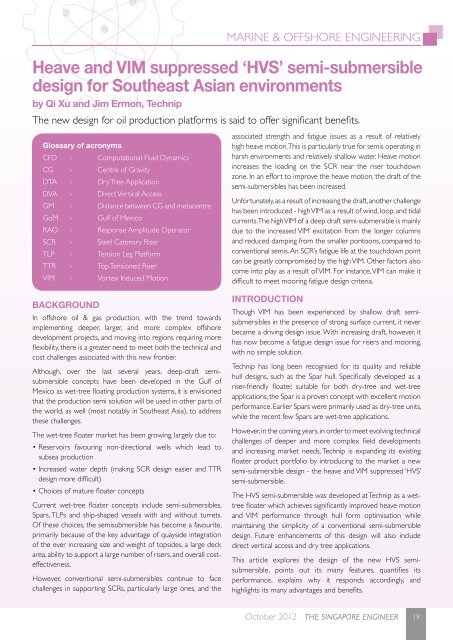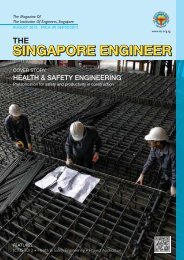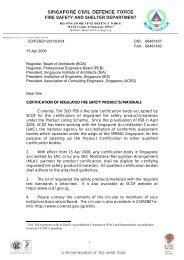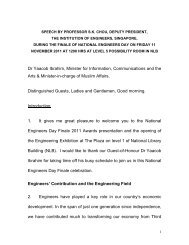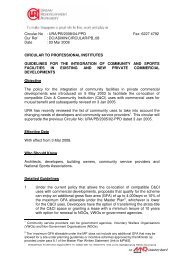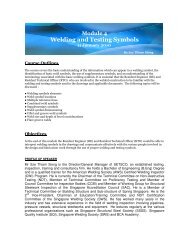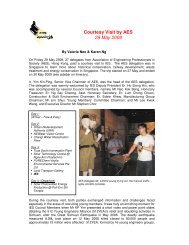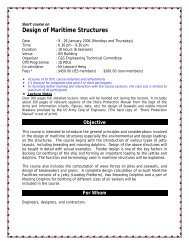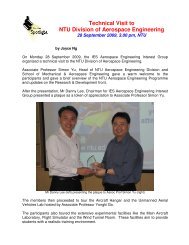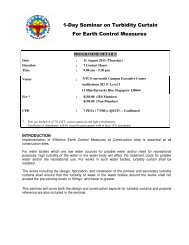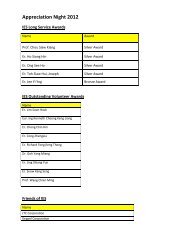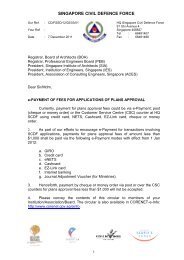singapore engineer singapore engineer singapore engineer
singapore engineer singapore engineer singapore engineer
singapore engineer singapore engineer singapore engineer
Create successful ePaper yourself
Turn your PDF publications into a flip-book with our unique Google optimized e-Paper software.
MARINE & OFFSHORE ENGINEERING<br />
Heave and VIM suppressed ‘HVS’ semi-submersible<br />
design for Southeast Asian environments<br />
by Qi Xu and Jim Ermon, Technip<br />
The new design for oil production platforms is said to offer significant benefits.<br />
Glossary of acronyms<br />
CFD - Computational Fluid Dynamics<br />
CG - Centre of Gravity<br />
DTA - Dry Tree Application<br />
DVA - Direct Vertical Access<br />
GM - Distance between CG and metacentre<br />
GoM - Gulf of Mexico<br />
RAO - Response Amplitude Operator<br />
SCR - Steel Catenary Riser<br />
TLP - Tension Leg Platform<br />
TTR - Top Tensioned Riser<br />
VIM - Vortex Induced Motion<br />
BACKGROUND<br />
In offshore oil & gas production, with the trend towards<br />
implementing deeper, larger, and more complex offshore<br />
development projects, and moving into regions requiring more<br />
flexibility, there is a greater need to meet both the technical and<br />
cost challenges associated with this new frontier.<br />
Although, over the last several years, deep-draft semisubmersible<br />
concepts have been developed in the Gulf of<br />
Mexico as wet-tree floating production systems, it is envisioned<br />
that the production semi solution will be used in other parts of<br />
the world, as well (most notably in Southeast Asia), to address<br />
these challenges.<br />
The wet-tree floater market has been growing, largely due to:<br />
• Reservoirs favouring non-directional wells which lead to<br />
subsea production<br />
• Increased water depth (making SCR design easier and TTR<br />
design more difficult)<br />
• Choices of mature floater concepts<br />
Current wet-tree floater concepts include semi-submersibles,<br />
Spars, TLPs and ship-shaped vessels with and without turrets.<br />
Of these choices, the semisubmersible has become a favourite,<br />
primarily because of the key advantage of quayside integration<br />
of the ever increasing size and weight of topsides, a large deck<br />
area, ability to support a large number of risers, and overall costeffectiveness.<br />
However, conventional semi-submersibles continue to face<br />
challenges in supporting SCRs, particularly large ones, and the<br />
associated strength and fatigue issues as a result of relatively<br />
high heave motion. This is particularly true for semis operating in<br />
harsh environments and relatively shallow water. Heave motion<br />
increases the loading on the SCR near the riser touchdown<br />
zone. In an effort to improve the heave motion, the draft of the<br />
semi-submersibles has been increased.<br />
Unfortunately, as a result of increasing the draft, another challenge<br />
has been introduced - high VIM as a result of wind, loop, and tidal<br />
currents. The high VIM of a deep draft semi-submersible is mainly<br />
due to the increased VIM excitation from the longer columns<br />
and reduced damping from the smaller pontoons, compared to<br />
conventional semis. An SCR’s fatigue life at the touchdown point<br />
can be greatly compromised by the high VIM. Other factors also<br />
come into play as a result of VIM. For instance, VIM can make it<br />
difficult to meet mooring fatigue design criteria.<br />
INTRODUCTION<br />
Though VIM has been experienced by shallow draft semisubmersibles<br />
in the presence of strong surface current, it never<br />
became a driving design issue. With increasing draft, however, it<br />
has now become a fatigue design issue for risers and mooring,<br />
with no simple solution.<br />
Technip has long been recognised for its quality and reliable<br />
hull designs, such as the Spar hull. Specifically developed as a<br />
riser-friendly floater, suitable for both dry-tree and wet-tree<br />
applications, the Spar is a proven concept with excellent motion<br />
performance. Earlier Spars were primarily used as dry-tree units,<br />
while the recent few Spars are wet-tree applications.<br />
However, in the coming years, in order to meet evolving technical<br />
challenges of deeper and more complex field developments<br />
and increasing market needs, Technip is expanding its existing<br />
floater product portfolio by introducing to the market a new<br />
semi-submersible design - the heave and VIM suppressed ‘HVS’<br />
semi-submersible.<br />
The HVS semi-submersible was developed at Technip as a wettree<br />
floater which achieves significantly improved heave motion<br />
and VIM performance through hull form optimisation while<br />
maintaining the simplicity of a conventional semi-submersible<br />
design. Future enhancements of this design will also include<br />
direct vertical access and dry tree applications.<br />
This article explores the design of the new HVS semisubmersible,<br />
points out its many features, quantifies its<br />
performance, explains why it responds accordingly, and<br />
highlights its many advantages and benefits.<br />
October 2012 THE SINGAPORE ENGINEER<br />
19


